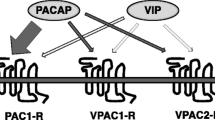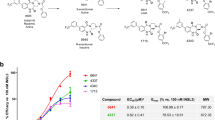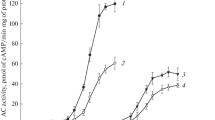Abstract
In connection with our discovery of the adenylyl cyclase signaling mechanism (ACSM) of action of some peptides belonging to the insulin superfamily, a possibility of its involvement in action of another insulin superfamily peptide, relaxin, was studied. It was shown for the first time that human relaxin-2 (10−12–10−8 M) activated adenylyl cyclase (AC) in a dose-dependent manner. The maximal peptide effect was revealed at a concentration of 10−8 M. Under condition of the hormonal action the basal enzyme activity increased by +310% in human myometrium, by +117%, in rat skeletal muscles, and by +49%, in foot smooth muscles of the bivalve mollusc Anodonta cygnea. Insulin and mammalian insulin-like growth factor-I (IGF-I) also produced the AC activating effect in these muscles. The order of efficiency of these peptides, based on their ability to induce the maximal AC stimulating effect, was as follows: relaxin > IGF-I > insulin (human myometrium); IGF-I > relaxin > insulin (rat skeletal muscle); insulin-like peptide of Anodonta (ILPA) > IGF-I > insulin > relaxin (molluscan muscle). The relaxin activating effect on AC was potentiated by a guanine nucleotide, the non-hydrolyzed analog of GTP, guanylylimidodiphosphate (Gpp[NH]p), which indicates participation of Gs-protein in realization of this effect. This effect was inhibited by a tyrosine kinase selective blocker, tyrphostin 47, and a phosphatidylinositol-3-kinase (PI-3-K) selective blocker, wortmannin. Thus, for the first time, participation of ACSM in the relaxin action has been established. This mechanism, as suggested at the present time state of its study, includes the following signal pathway: receptor-tyrosine kinase ⇒ PI-3-K ⇒ Gs-protein ⇒ AC.
Similar content being viewed by others
REFERENCES
Chan, S.J., Nagamatsu, S., Cao, Q.P., and Steiner, D.F., Structure and Evolution of Insulin and Insulin-Like Growth Factors in Chordates, Progress in Brain Research (Joosse, J., Buijs, R.M., and Tilders, F.J.H., Eds., Amsterdam: Elsevier Science), 1992, vol. 92, pp. 15–24.
Murray-Rust, J., Macleod, A.N., Blundell, T.L., and Wood, S.P., Structure and Evolution of Insulins: Implifications for Receptor Binding, BioEssays, 1992, vol. 14, pp. 325–331.
Bryant-Greenwood, G.D. and Schwabe, C., Human Relaxins: Chemistry and Biology, Endocrine Reviews, 1994, vol. 15, pp. 5–26.
Bullesbach, E.E., Yang, S., and Schwabe, C., The Receptor-Binding Site of Human Relaxin 2. A Dual Prong-Binding Mechanism, J. Biol. Chem., 1992, vol. 267, pp. 22957–22960.
Pertseva, M.N., Plesneva, S.A., Shpakov, A.O., et al., Involvement of the Adenylyl Cyclase Signaling System in the Action of Insulin and Mollusc Insulin-Like Peptide, Comp. Biochem. Physiol., 1995, vol. 112B, pp. 689–695.
Pertseva, M.N., Plesneva, S.A., Kuznetsova, L.A., et al., On the Tyrosine Kinase Mechanism of the Novel Effect of Insulin and Insulin-Like Growth Factor–Stimulation of the Adenylyl Cyclase System in Muscle Tissue, Biochem. Pharmacol., 1996, vol. 52, pp. 1867–1874.
Derkach, K.V., Kuznetsova, L.A., Plesneva, S.A., and Pertseva, M.N., Ontogenetic Method of the Study of Adenylyl Cyclase Stimulating Effect of Insulin and Its Possible Role in Regulatory Action of the Hormone, Zh. Evol. Biokhim. Fiziol., 1997, vol. 33, pp. 131–137.
Pertseva, M.N., Shpakov, A.O., and Plesneva, S.A., Current Advances in Studies on Signaling Mechanisms of Action of Insulin and Related Peptides, Zh. Evol. Biokhim. Fiziol., 1996, vol. 32, pp. 258–279.
McIlwrath, A., Downing, S.J., and Hollingsworth, M., Relaxin and cAMP in Rat Uterus in vivo, Biochem. Soc. Transact., 1991, vol. 19, p. 356S.
Hughes, S.J., Hollingsworth, M., and Elliot, K.R., The Role of a cAMP-Dependent Pathway in the Uterine Relaxant Action of Relaxin in Rats, J. Reprod. Fertil., 1997, vol. 109, pp. 289–296.
Cronin, M.J., Malaska, T., and Bakhit, C., Human Relaxin Increases Cyclic AMP Levels in Cultured Anterior Pituitary Cells, Biochem. Biophys. Res. Commun., 1987, vol. 148, pp. 1246–1251.
Bigazzi, M., Brandi, M.L., Bani, G., and Bani Sacchi, T., Relaxin Influences the Growth of MCF-7 Breast Cancer Cells. Mitogenic and Antimitogenic Action Depends on Peptide Concentration, Cancer, 1992, vol. 70, pp. 639–643.
Kidwai, A.M., Radcliffe, M.A., Lee, E.Y., and Daniel, E.E., Isolation and Properties of Skeletal Muscle Membranes, Biochim. Biophys. Acta, 1973, vol. 298, pp. 593–607.
Rusakov, Yu.I., Bondareva, V.M., Karasev, V.S., et al., Some Biochemical Characteristics of an Insulin-Like Substance of the Bivalve Mollusc Anodonta cygnea, Biokhimiya, 1991, vol. 56, pp. 718–726.
Bullesbach, E.E. and Schwabe, C., On the Receptor Binding Site of Relaxins, Int. J. Peptide Res., 1988, vol. 32, pp. 361–367.
Levitzki, A., Tyrphostins: Tyrosine Kinase Blockers as Novel Antiproliferative Agents and Dissectors of Signal Transduction, FASEB J., 1992, vol. 62, pp. 3275–3282.
Yano, H., Nakanishi, S., Kimura, K., et al., Inhibition of Histamine Secretion by Wortmannin through the Blockage of Phosphatidylinositol-3-Kinase in RBL-2H3 Cells, J. Biol. Chem., 1993, vol. 268, pp. 25 846–25 856.
Salomon, Y., Londons, C., and Rodbell, M., A Highly Sensitive Adenylate Cyclase Assay, Anal. Biochem., 1974, vol. 58, pp. 541–548.
White, A.A., Separation and Purification of Cyclic Nucleotides by Alumina Column Chromatography, Methods Enzymol., 1974, vol. 380, pp. 41–46.
Lowry, O.H., Rosenbrough, N.J., Farr, A.L., and Randall, R.J., Protein Measurement with the Folin Phenol Reagent, J. Biol. Chem., 1951, vol. 193, pp. 265–275.
Plesneva, S.A., Shpakov, A.O., Rusakov, Yu.I., et al., The Involvement of Adenylate Cyclase Signaling System in the Action of Insulin, Epidermal Growth Factor and Insulin-Like Peptide of Mollusc Anodonta cygnea, Proceedings of 17th Conference of European. Comp. Endocrinologists, Roubos, E.W., Ed., 1994, Spain, September 5–10, Universiteit Cordoba (Univ. Press), 1994, abs. 135.
Pertseva, M.N., Contribution of Evolutionary Endocrinology in Study of Structure and Mechanisms of Action of Insulin and Related Peptides, St. Petersburg Academy of Sciences in the World Academic History, 1999, vol. 1, pp. 282–294.
Yang, S., Rembiesa, B., Bullesbach, E.E., and Schwabe, C., Relaxin Receptors in Mice: Demonstration of Ligand Binding in Symphyseal Tissues and Uterine Membrane Fragments, Endocrinology, 1992, vol. 130, pp. 179–185.
Petersen, L.K., Vogel, I., Oxlund, H., et al., No Effects of Human Relaxin on the Active and Passive Biomechanical Properties of Isolated Cervical Specimens from Nonpregnant Women, Eur. J. Obstet. Gynecol. Reprod. Biol., 1997, vol. 73, pp. 183–187.
MacLenman, A.H., Grant, P., and Bryant-Greenwood, G., HRLX-1 in vitro Response of Human and Pig Myometrium, J. Reprod. Med., 1995, vol. 40, pp. 703–706.
Schwabe, C. and Bullesbach, E.E., Relaxin, Structures, Functions, Promises, and Nonevolution, FASEB J., 1994, vol. 8, pp. 1152–1160.
Osheroff, P.L., Cronin, M.J., and Lofgren, J.A., Relaxin Binding in the Rat Heart Atrium, Proc. Nath. Acad. Sci., 1992, vol. 89, pp. 2384–2388.
Osheroff, P.L. and Ho, W.-H., Expression of Relaxin mRNA and Relaxin Receptors in Postnatal and Adult Rat Brains and Hearts. Localization and Development Patterns, J. Biol. Chem., 1992, vol. 268, pp. 15193–15199.
Roovers, J.F.A., Heerikhuizen, H. van, Ceraerts, W.H.M., et al., The Isolation of Genes Encoding the Receptor(s) for Molluscan Insulin-Related Peptides (MIPs) from Freshwater Snail Lymnaea stagnalis, Proceedigs of the Symposium on Molluscan Neurobiology, Vrije Universiteit, Amsterdam, The Netherlands, August 20–24, 1990, Roubos, E.W., Ed., p. 121, University Press, Amsterdam, 1990.
Meera, P., Anwer, R., Monga, M., et al., Relaxin Stimulates Myometrial Calcium-Activated Potassium Channel Activity via Protein Kinase A, Amer. J. Physiol., 1995, vol. 269, pp. 312–317.
Fei, D.T.W., Gross, M.C., Lofgren, J.L., et al., Cyclic AMP Response to Recombinant Human Relaxin by Cultured Human Endometrial Cells–A Specific and High Throughput in vitro Bioassay, Biochem. Biophys. Res. Comm., 1990, vol. 170, pp. 214–222.
Todoroki, N., Osa, T., and Cui, D., Pretreatment with Porcine Relaxin and Mg Ions Enhances Inhibitory Effects of Dibutyryl Cyclic AMP in Longitudinal Muscle of Estrogen-Treated Rat Myometrium, Jap. J. Physiol., 1995, vol. 45, pp. 108–113.
Parscell, D.A., Mak, J.Y., Ameto, E.P., and Unemori, E.N., Relaxin Binds to and Elicits a Response from Cells of the Human Monocytic Cell Line, THP-1, J. Biol. Chem., 1996, vol. 271, pp. 27 936–27 941.
Zhang, Q. and Bagnell, C.A., Relaxin Stimulation of Porcine Granulosa Cell Deoxyribonucleic Acid Synthesis in vitro: Interaction with Insulin and Insulin-Like Factor I, Endocrinology, 1993, vol. 132, pp. 1643–1650.
Burger, L.L. and Sherwood, O.D., Evidence That Cellular Proliferation Contributes to Relaxin-Induced Growth of Both the Vagina and the Cervix in the Pregnant Rat, Endocrinology, 1995, vol. 136, pp. 4820–4826.
Bani Sacchi, T., Brandi, M.L., Falchetti, A., and Bigazzi, M., Relaxin Influence Growth, Differentiation and Cell–Cell Adhesion of Human Breast–Cancer Cells in Culture, Int. J. Cancer, 1994, vol. 57, pp. 129–134.
Author information
Authors and Affiliations
Rights and permissions
About this article
Cite this article
Plesneva, S.A., Kuznetsova, L.A., Omel'yanyuk, E.V. et al. Adenylyl Cyclase Signaling Mechanism of Relaxin Action. Journal of Evolutionary Biochemistry and Physiology 36, 734–743 (2000). https://doi.org/10.1023/A:1017578822254
Issue Date:
DOI: https://doi.org/10.1023/A:1017578822254




